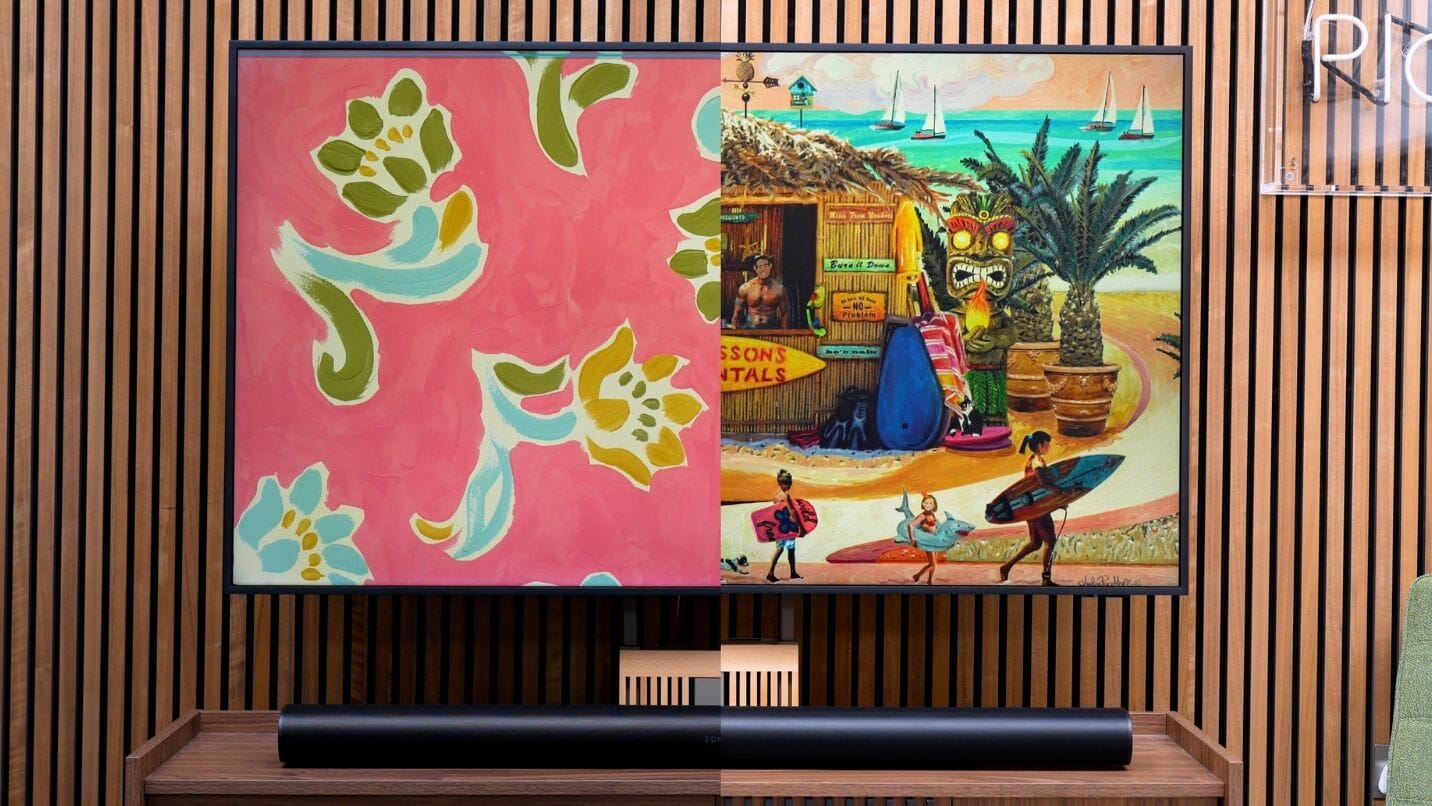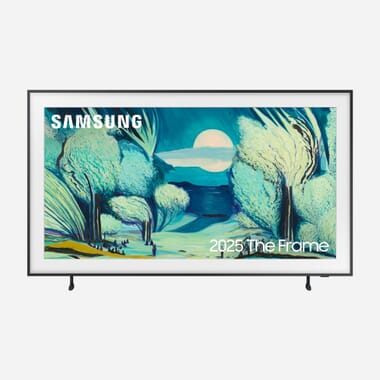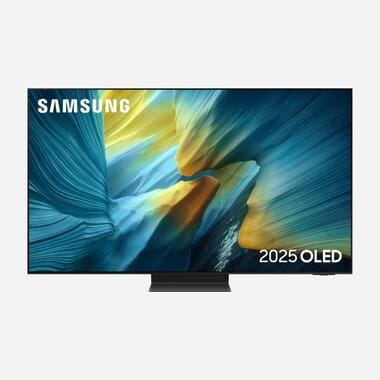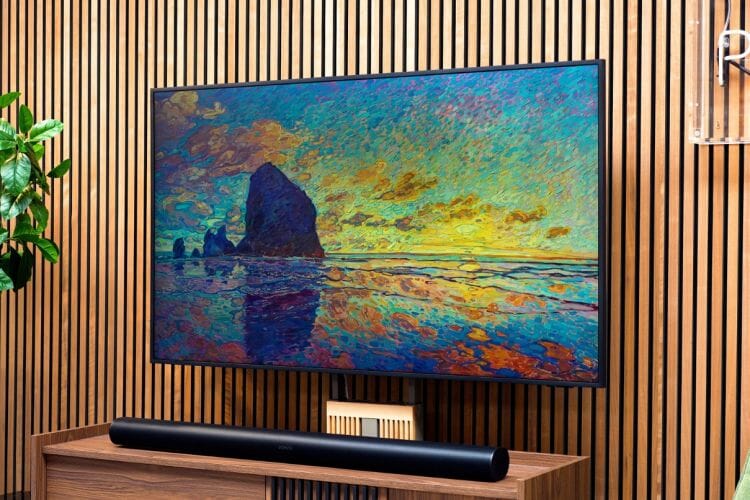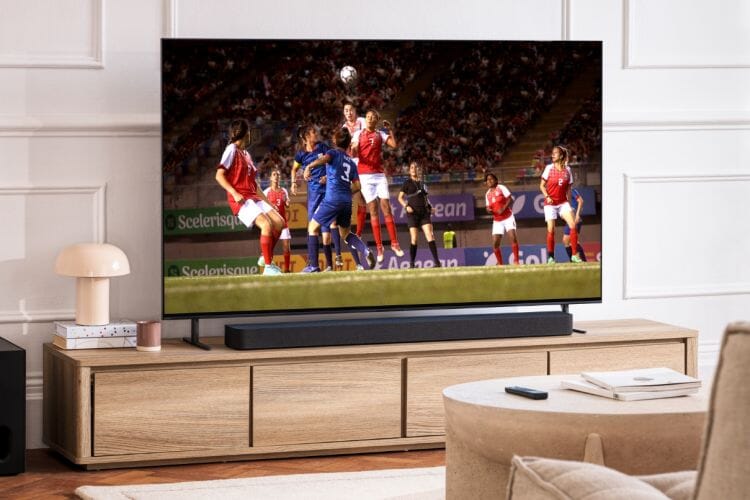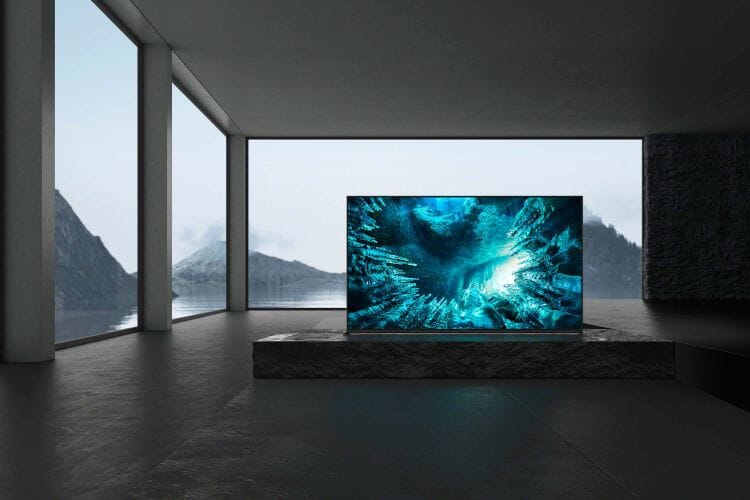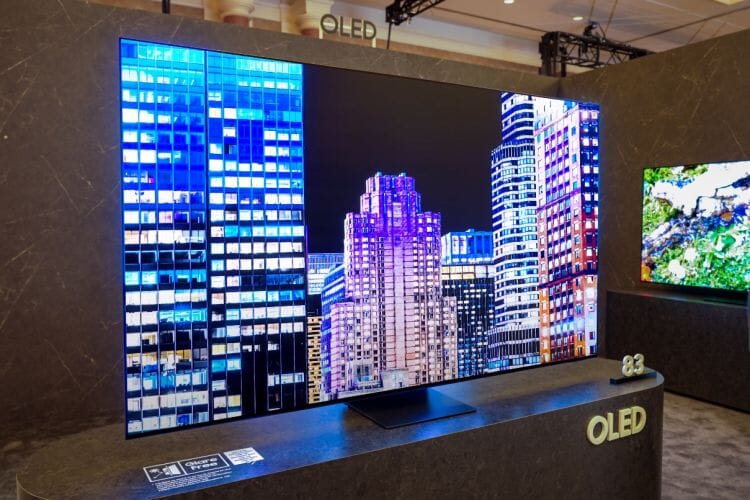The Frame vs The Frame Pro: What's The Difference?
The Samsung Frame has become one of the most talked about TVs over the last few years. Interior designers love it. Homeowners love it. And let’s be honest, it might even be the only bit of tech your partner actually likes having in the living room.
But now there’s a new kid on the block, the Samsung Frame Pro. It looks almost identical, but under the hood it promises to fix the one thing the original frame never quite nailed: picture quality. So, when it comes to Frame vs Frame Pro, which is worth your money? We've tested both to find out.
We’ve also put together a YouTube breakdown of the Frame vs Frame Pro if you’d rather watch the Frame vs Frame Pro side by side...
Samsung Frame vs. Frame Pro: SHS 60-Second Summary
Samsung The Frame (2025) Available Sizes: 43", 50", 55", 65" (See Latest Price) |
| Pros: ✓ Timeless, customisable design ✓ Matte display reduces glare in bright rooms ✓ Now supports 144Hz refresh rate ✓ More affordable than the Pro Cons: ✖ Not as bright as The Frame Pro ✖ No wireless One Connect box ✖ Smaller maximum size (65") |
Samsung The Frame Pro (2025) Available Sizes: 65", 75", 85" (See Latest Price) |
| Pros: ✓ Neo QLED panel with vertical local dimming ✓ Brighter, more contrast-rich picture ✓ Wireless One Connect box ✓ NQ4 Gen3 AI processor (same as flagship S95F OLED) Cons: ✖ More expensive than The Frame ✖ No smaller sizes ✖ Fully reliant on wireless link for main connections |
Samsung Frame vs. Frame Pro: What's Actually Changed?

| Feature | Samsung The Frame (2025) | Samsung Frame Pro (2025) |
|---|---|---|
| Panel Type | QLED | Neo QLED (Mini LED) |
| Processor | NQ4 AI Gen2 | NQ4 AI Gen3 |
| Peak Brightness (claimed) | 400 nits | 1000 nits |
| HDMI Ports | 4x HDMI 2.1 (wired) | 4x HDMI 2.1 (wireless), 1x micro HDMI on TV |
| One Connect Box | Wired | Wireless |
| Available Sizes | 43", 50", 55", 65" | 65", 75", 85" |
The biggest upgrade with the Frame Pro is in the panel. The standard Frame still uses a QLED panel, but the Frame Pro steps up to Neo QLED with vertical local dimming.
This gives more precise backlight control, deeper blacks, better contrast, and a noticeable boost in peak brightness. Samsung quotes around 1000 nits peak brightness compared to roughly 400 on the standard model, and in side by side viewing that difference is easy to see.
The processor is another clear difference. The Pro uses the NQ4 Gen3 AI Processor, the same chip as Samsung’s flagship S95F OLED for 2025. This means faster and more accurate motion handling, smarter HDR tone mapping, and cleaner upscaling for non-4K content.
One of the biggest talking points is the Wireless One Connect box. On The Frame, all inputs live in a separate One Connect box connected to the TV by a slim, transparent cable. On the Pro, that cable is gone.
The Wireless One Connect box is considerably smaller and now sends everything, including full 4K at 120Hz, over Wi-Fi 7. This means you can hide your devices in a cabinet or even another room, up to ten metres away, for a cleaner wall installation.
There are some important things to keep in mind. You can't fall back to a wired One Connect cable if the wireless link is unstable. That means wireless performance depends heavily on having a strong and stable home network, so we'd recommend bearing that in mind if you're tempted by the Pro model.
The Frame Pro includes a micro HDMI port on the TV itself for a direct connection to a games console. This is mainly for serious gamers who want to bypass the wireless link and eliminate any potential input lag. For most households though, the wireless One Connect box will still handle everything without issue.
The standard Frame might not have the all-new tech found in the Pro, but the 2025 version still brings a few subtle yet worthwhile upgrades of its own.
You still get the signature gallery-style design with its matte display and slim bezels, but now it supports a higher 144Hz refresh rate and uses a refined NQ4 AI Gen2 processor.
Samsung hasn't radically changed the panel technology, but these updates bring noticeable improvements in smoothness, clarity, and everyday performance, especially for bright-room and casual viewing setups.
Read More: Samsung S95F Review: The QD-OLED To Beat?
Samsung Frame vs. Frame Pro: Pricing & Availability
At the 65-inch size, the Frame Pro costs roughly £200 more than the standard Frame. This is also the only size where you can choose between both models.
If you want something smaller, the standard Frame is your only option, while anyone going for 75 inches or larger will need to choose the Pro.
Here is how the range looks in 2025:
| Size | Samsung The Frame (RRP) | Samsung The Frame Pro (RRP) |
|---|---|---|
| 43-inch | £1,099 | No Model Available |
| 50-inch | £1,299 | No Model Available |
| 55-inch | £1,499 | No Model Available |
| 65-inch | £1,899 | £2,099 |
| 75-inch | No Model Available | £2,999 |
| 85-inch | No Model Available | £3,999 |
In terms of value, the standard Frame is the more affordable way to get Samsung’s design-led lifestyle TV, especially if you don't need the extra brightness, bigger screen or the wireless connection.
However, the Frame Pro’s higher price is justified by its performance upgrades, cleaner installation, and larger size options, but it is worth checking for seasonal offers or bundles that can narrow the gap.
Samsung Frame vs. Frame Pro: Design and Build Quality
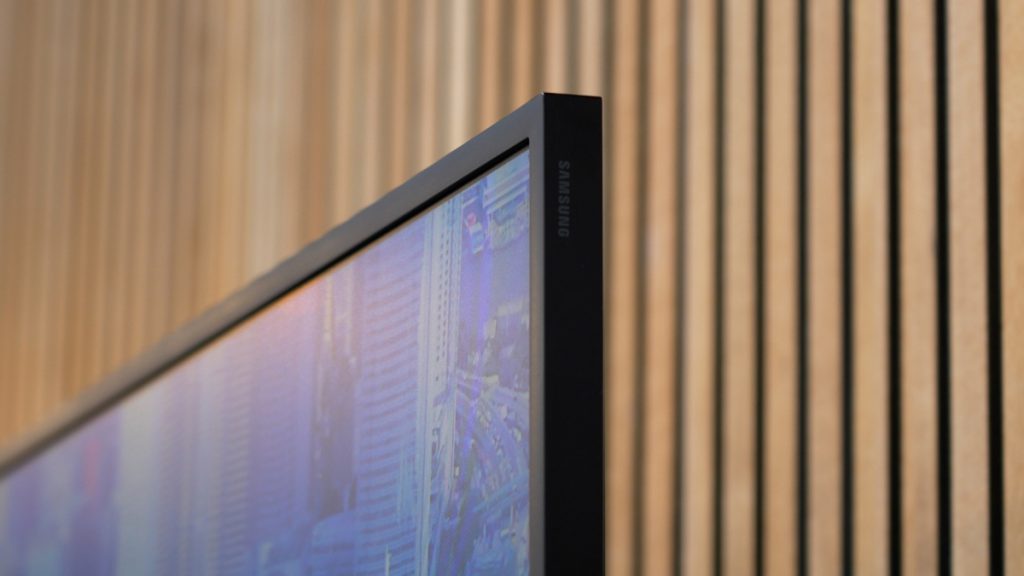
Let’s be honest, design is the reason The Frame took off in the first place, and it is still the main reason most people fall for it. The good news is that whether you go for the standard model or the Pro, you are getting that same gallery-style aesthetic that turns a TV into a piece of wall art.
Both are super slim and look great flush-mounted with the included No-Gap Wall Mount. If you prefer a cabinet setup, they come with feet too, although in our experience most people go straight for the wall.
The matte display finish is still one of the biggest selling points, cutting down reflections so your art looks convincing rather than like a shiny TV pretending to be a picture frame.
You can still swap out bezels to match your décor, but there is one thing to note. The Pro uses slightly different bezels because of a new light sensor and control panel, so you cannot just reuse frames from your older model. A little annoying, yes, but at least it opens the door to picking something fresh.
Around the back, the Frame Pro looks as clean as it does from the front. Thanks to the wireless connection to its One Connect box, there’s no visible signal cable trailing down the wall, just the power lead. If you care about keeping your setup looking as minimal as possible, that wireless approach makes a real difference compared to the wired setup on the standard model.
Samsung Frame vs. Frame Pro: Features

As you could probably guess, both the Samsung Frame and Frame Pro share a lot of the same smarts. They run Samsung’s Tizen platform, so you get all the big streaming apps, a straightforward interface, and extras like Samsung TV Plus if you fancy some free channels. Both support HDR10, HDR10+, and HLG, but as always with Samsung, there’s no Dolby Vision.
You also get Art Mode on both, which is the magic trick that makes The Frame so unique. It swaps your Netflix queue for a curated piece from the Samsung Art Store when you are not watching TV. You get a small selection included out of the box, but the full library is subscription-based. Or, if you prefer something more personal, you can upload your own photos for a custom touch.
Where the Pro edges ahead is in the extra tools it offers. It has SmartThings Calibration Pro for fine-tuning your picture using your phone’s camera, plus Auto HDR Remastering that gives standard content more HDR-like punch.
The standard Frame is no slouch though. Its NQ4 AI Gen2 chip keeps navigation snappy, handles upscaling nicely, and now supports that higher 144Hz refresh rate, which could come in handy for gaming or sports.
Samsung Frame vs. Frame Pro: Picture Quality
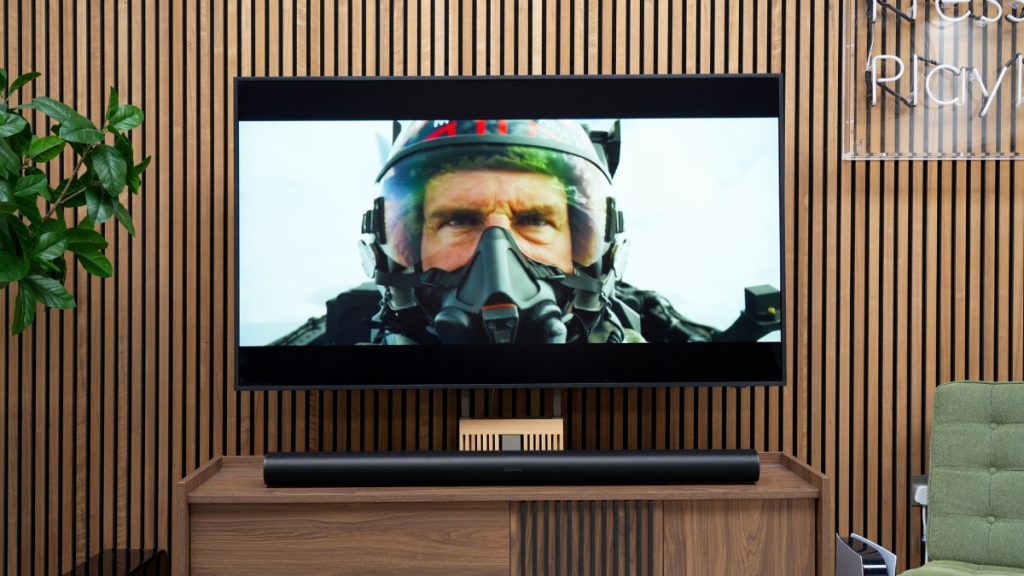

We've tested the Frame and the Frame Pro side by side in both our studio and bright showroom space, and while they share a lot of strengths, there are some clear differences that give the Pro an edge in overall performance.
Here’s a quick breakdown of what we thought of each model when we reviewed them:
| Samsung Frame (2025) | Samsung Frame Pro (2025) |
|---|---|
| Strengths: ✅ Timeless, design-led appeal ✅ Matte display is great for bright rooms ✅ Smooth motion handling | Strengths: ✅ Brighter, more contrast-rich picture ✅ Better shadow details ✅ Richer, more vibrant colour in HDR ✅ Great motion handling |
| Weaknesses: ❌ Not as bright as the Frame Pro ❌ Slightly flatter colour performance | Weaknesses: ❌ Black levels not as cinematic as flagship OLED or Neo QLED models |
The first thing that stands out is brightness. Even something as simple as the Apple TV home screen shows the difference straight away. Samsung claims around 1000 nits peak brightness versus roughly 400 on the standard model. We always look beyond the specs to real-world performance, but in day-to-day viewing that step up is obvious.
That improvement is partly thanks to the switch from QLED to Neo QLED with vertical local dimming. It is not the same full array local dimming tech you will find in Samsung’s higher-end Neo QLEDs, but it still gives the Pro far better control over contrast and shadow detail. It is not perfect, but for a design-led TV, it is a clear step in the right direction.
You can really see that in Spider-Man: Homecoming (2017). The sunlit stonework during the Monument Rescue scene has extra pop and depth, and overall colour across the shot just feels more alive and engaging. The grass in the background is a noticeably richer green, and Spider-Man’s suit pops with those deeper reds and blues.
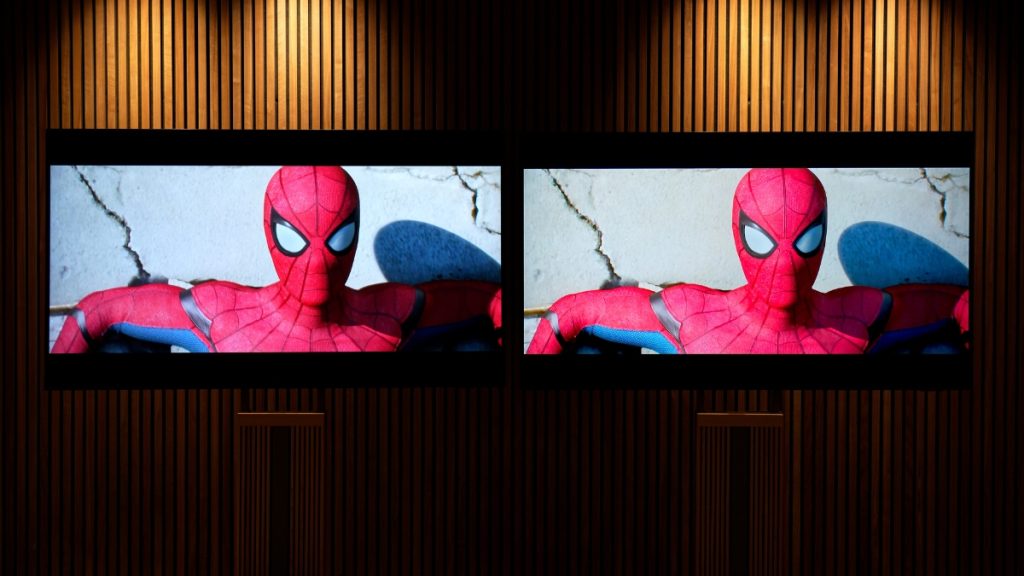
The Pro definitely pushes colour a touch more than the standard Frame, and while it is maybe a bit more saturated, for bright, dynamic scenes like this it works in its favour.
Motion handling is strong on both TVs. Watching things like live sports, or the F1 trailer for example, there is no tearing, no dropped frames, and only minimal blur on fast pans. The Pro is maybe just a touch cleaner here, but the difference is so slight you would only pick it out in a direct side-by-side.
Both sets support refresh rates up to 144Hz, which sounds impressive, but you are not going to see that in most everyday viewing because sports broadcasts and streaming content are still locked to much lower frame rates. Where it could make a difference is if you are plugging in a gaming PC or a console that can take advantage of it.
Black levels are interesting, because side by side, the standard Frame actually looks a touch darker in the blackest parts of the image. But the Pro reveals more detail in those darker areas.
In Alien (1979), for example, when you have those deep space shots, the standard Frame might give you a more true black background, but the Pro lets you see more of the subtle variations in the shadows so things do not just disappear into one solid block. It was a similar story in The Darkest Hour (2018), during the tunnel scene. On the Pro, you can pick out more of the texture in the walls behind the character, which adds a nice sense of depth in our opinion.
That matte finish also has an effect on picture performance. In bright spaces or near windows, it stops reflections from washing out the image. In a dark room, though, it can slightly soften contrast compared to a glossy screen, so it’s a trade-off worth keeping in mind.
For context we did most of my testing in Standard mode because that is where most people will end up watching. That said, there is a whole range of picture modes to try. AI mode is probably the standout. It adapts the image on the fly to whatever you are watching and wherever you are watching it, and it works well on both models. Regardless of which you pick, it is the mode I would recommend if you just want to sit back and enjoy your TV.
Read More: Best TVs for Movies (2025): Our 6 Top Picks for Home Cinema
Samsung Frame vs. Frame Pro: Sound Performance

When it comes to sound performance, both the Frame Pro and standard Frame are almost identical. You are getting a 2.0.2 channel stereo speaker setup with 40W of output, support for Dolby Atmos, and Samsung’s Object Tracking Sound and Adaptive Sound tech built in.
For casual viewing, it does the job nicely. Dialogue is clear, and there is enough volume to comfortably fill a living room. But, as you might expect, if audio quality is a big deal for you, adding a soundbar or external speakers will take things up a level.
That said, we know not everyone wants to invest in a sleek, design-led TV like this only to park a big soundbar right in front of it. If that sounds like you, Samsung offers a couple of lifestyle soundbars, such as the Samsung HW-S801D or Samsung HW-S701D , which are designed to visually match The Frame. They keep the clean, gallery-style look intact while giving you a noticeable audio upgrade.
From what we have heard in demo sessions at CES and during hands-on time with Samsung, these soundbars sound promising and are worth checking out if you want to boost audio without sacrificing style.
Samsung Frame vs. Frame Pro: Gaming
The Frame has never really been pushed as a gaming-first TV, but both the standard model and the Pro are surprisingly capable when it comes to specs. You get 4K at 120Hz, VRR, ALLM, and four HDMI 2.1 ports, with support for up to 144Hz on compatible hardware.
The Pro’s wireless connection has had some gamers questioning whether it adds extra input lag. We’ve seen reports quoting 0.20–0.30ms, which is still quick, but not as fast as a direct wired link.
In our own testing, casual play felt perfectly responsive, but Samsung has included a micro HDMI port for anyone who wants the reassurance of bypassing the wireless link entirely.
For most households, both models will handle gaming smoothly and responsively. Unless you are chasing the absolute lowest latency, the gaming performance on either set is more than enough for consoles, casual PC gaming, and cloud services.
Our Verdict: Which Should You Buy?
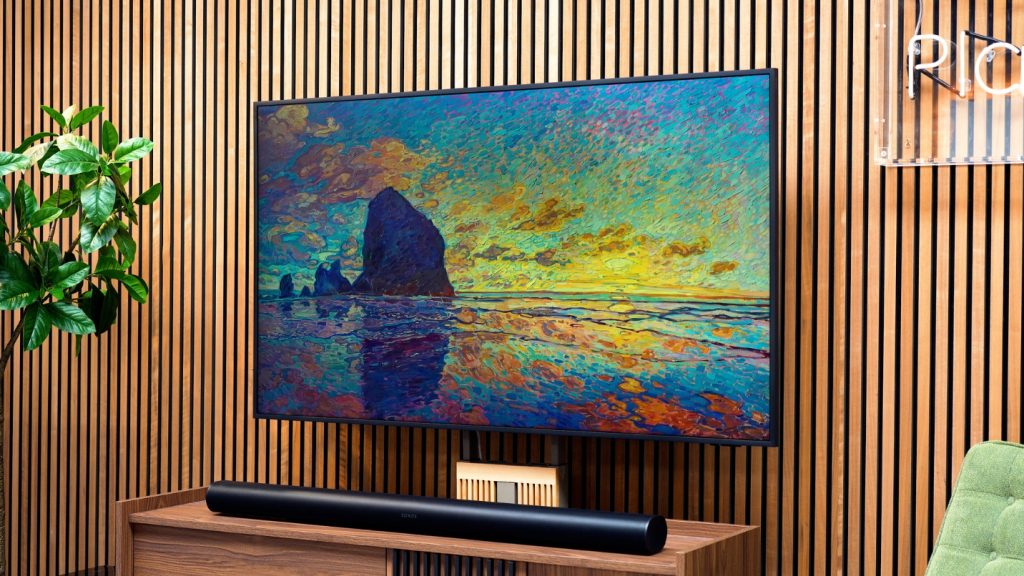
The Frame Pro feels like the natural next step for anyone who loves the whole concept of Samsung's artwork-style TVs but has been waiting for that extra bump in performance.
You are getting a brighter, more refined picture and the Wireless One Connect box makes for one of the cleanest, most living-room-friendly setups we have seen to date.
It is not without a couple of trade-offs though. The big one is the step up in cost. At around £200 more for the 65-inch version, you are in a price range where LG, Sony, and even Samsung’s own higher-end models can offer better raw picture performance for the money.
That said, none of them do what The Frame does. None blend into your space in quite the same way. And now, with the Pro, you are not having to compromise nearly as much on picture quality to get that look.
The standard Frame is still a brilliant option. It's the only choice if you want one of the smaller sizes, it still delivers the full Art Mode experience, and for everyday TV, streaming, and sports it works really well. If you would rather keep some budget back for a soundbar or a few extra bezels, we can see exactly why you would still opt for this one.
Should you rush to upgrade if you already own an older Frame? Not necessarily. If design is your main priority, the standard model still absolutely nails it.
But if you are going bigger and you want The Frame look with a clear step up in performance, the Pro feels like the most complete version yet. (You can check out our full Samsung Frame Pro Review for all our testing results and impressions.)
The best thing is you finally have the choice. You don't have to pick between aesthetics and picture quality anymore, and for us as consumers, that can only be a good thing.
Other Useful Content
Blog: TV Buying Guide Everything You Need To Know
Blog: Sony Bravia 9 Review: The Right Choice in 2025?
Video: TV Panel Type Buying Guide: OLED vs QLED vs QNED vs Micro LED vs Mini LED & More
For more information about Samsung TVs or any other TV products, get in touch and one of our Tech Guides would be happy to help!
Why buy from Smart Home Sounds? We offer Lowest Price Guarantee, Free Next Day Delivery* and 0% Finance Available. Looking for more personal advice? Contact our team of experts today. Shop TV



